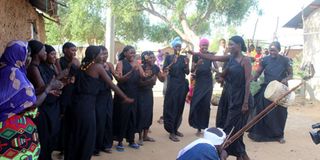Where FGM follows girls, women to delivery room

What you need to know:
- In Tana River County, the blade has not taken a break; if you miss it as a child, the midwife may still catch up with you in adulthood.
- Zainab Haloni, 33, was abandoned by her husband when she was three months pregnant after he discovered she was not circumcised.
- Communities have devised new methods of performing the cut, especially during the Covid-19 pandemic.
- Some parents subjecting their girls to the cut at a tender age to avoid justice.
- Efforts to arrest traditional circumcisers frustrated by the discreet manner the practice is being carried out.
The war against Female Genital Mutilation (FGM) may have sent the traditional circumcisers into hiding, but not the cut out of the tradition.
In Tana River County, the blade has not taken a break, and the 'surgeons' retired.
If you miss the blade as a child, the women who double up as midwives may still catch up with you in your adulthood. The law of compensation will enjoy its day.
At the age of 16, Rabia Mohammed from the Ilwana community in Bura sub-county, a community that practices FGM, got married and knew she had escaped the traumatising experience.
The first four years of marriage were rosy, her husband loved her and they enjoyed intimacy. He was not aware she had not been circumcised.
"I was better this way. We lived in peace. Listening to what my friends went through in their marriages, the stories were harrowing and depressing,” she says.
Her joy was, however, short-lived months after she conceived. Numerous trips to a local midwife exposed her secret.

Fatuma Hajibo Jarso, a retired 69-year-old traditional FGM surgeon, during an interview at her home in Hamesa Village, Tana River County. PHOTO | STEPHEN ODUOR | NATION
"My husband left without saying a word, I was seven months pregnant then. I could see him around, but he never looked at or talked to me; all I heard people saying was that I was a prostitute," she says.
No one wanted to be associated with her and she became an outcast.
On the day of delivery, the midwife took advantage of her labour pains and circumcised her, leaving her in excruciating pain.
Although she has recovered, the journey was painful and traumatising and today, she lives with the pain of being subjected to the cut, a violation of her human right.
Ms Mohammad’s story is not an isolated one. Zainab Haloni, 33, was abandoned by her husband when she was three months pregnant after he discovered she was not circumcised.
According to anti-FGM activist Sadiya Hussein, communities have devised new methods of performing the cut especially during the Covid-19 pandemic.
"They are taking advantage of the curfew to carry out the exercise at night. Girls are facing a difficult time this period since campaigns against the cut have been affected by the pandemic," she says.
EARLY AGE
Ms Saadiya notes that the cut that initially targeted girls 12 years and below, has taken a new angle. Some parents, she says, have been subjecting their girls to the cut at a tender age to avoid justice.
Ms Sadiya adds that efforts to arrest traditional circumcisers have been frustrated by the discreet manner the practice is being carried out.
"We need more support is needed to enforce the law in the fight against FGM,” says Ms Sadiya.
Ms Hawaa Abdighafoor, reproductive health officer at the Hola Level Four Hospital, notes that more than 20 women report to the health facility with complications attributed to the cut, especially after giving birth.
Dr Abdighafoor notes that the tradition has condemned women to untold suffering.
Despite the enactment of the Anti-FGM law 2011, the practice is prevalent and continues to take different forms, frustrating efforts of activists in the fight against the abandonment of the practice.





